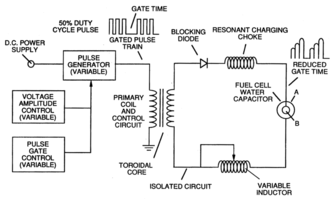Water fuel cell
Template:Alternative Fuel Sources


The water fuel cell, named by American Stanley Meyer, is a device designed to convert water into its component elements, hydrogen and oxygen, using less energy than can be obtained by the subsequent combustion of those elements.
Similar devices have been promoted by others (see Water-fuelled car):
Construction
The fuel cell consists of stainless steel plates arranged as a capacitor, with pure water acting as the dielectric. A rising staircase of direct current pulses is sent through the plates at roughly 42 kHz, which is claimed to play a role in the water molecules breaking apart with less directly applied energy than is required by standard electrolysis.
Its name not withstanding, the water fuel cell is not a true fuel cell. It would be an electrolytic cell, as it is claimed to produce hydrogen from water and not the opposite.[1]
Meyer's water-fueled car
It Runs on Water is a video with Stanley Meyer demonstrating the water fuel cell in a car.[2] Meyer claimed that he could run a 1.6 liter Volkswagen dune buggy on water instead of gasoline.[3] He replaced the spark plugs with "injectors" to spray a fine mist into the engine cylinders, which he claimed were electrified at a resonant frequency. The fuel cell would split water into hydrogen and oxygen gas, which would be combusted back into water vapor in a conventional internal combustion engine to produce net energy.[3] Meyer demonstrated his vehicle for his city's local station Action 6 News and estimated that only 83 liters (22 US gallons) of water was required to travel from Los Angeles to New York.[4]
Lawsuit
In 1996, inventor Stanley Meyer was sued by investors to whom he had sold dealerships, offering the right to do business in Water Fuel Cell technology. According to The Times, Meyer claimed in court that his invention "opened the way for a car which would 'run on water', powered simply by a car battery."[3] The car would even run perpetually without fuel since the energy needed to continue the "fracturing" was low enough for the engine's dynamo to recharge the car's battery.[3] His car was due to be examined by the expert witness Michael Laughton, Professor of Electrical Engineering at Queen Mary, University of London and Fellow of the Royal Academy of Engineering. However, Meyer made what Professor Laughton considered a "lame excuse" on the days of examination and did not allow the test to proceed.[3] The Water Fuel Cell, on the other hand, was examined by three expert witnesses in court who found that there "was nothing revolutionary about the cell at all and that it was simply using conventional electrolysis".[3]
On the basis of the evidence the court found Meyer guilty of "gross and egregious fraud" and ordered to repay the investors their $25,000.[3]
Death
Stanley Meyer died at the age of 57 after eating at a restaurant on 21 March 1998.[5] An autopsy report by Franklin County coroner William R. Adrion showed the cause of death to be a cerebral aneurysm. He died in 1998 after eating at a restaurant; the coroner diagnosed an aneurysm, but the conspiracy web still suspects he was poisoned.[5][6]
Trivia
- Like Water for Octane, season 1, episode 4 of The Lone Gunmen, a fictional TV series and spin-off from the X-files,[7] is based on a "water powered" car that character Melvin Frohike saw with his own eyes back in 1962.[8]
Patents
Stanley Meyer
- U.S. patent 5,149,407: Process and apparatus for the production of fuel gas and the enhanced release of thermal energy from such gas
- U.S. patent 4,936,961: Method for the production of a fuel gas
- U.S. patent 4,826,581: Controlled process for the production of thermal energy from gases and apparatus useful therefore
- U.S. patent 4,798,661: Gas generator voltage control circuit
- U.S. patent 4,613,779: Electrical pulse generator
- U.S. patent 4,613,304: Gas electrical hydrogen generator
- U.S. patent 4,465,455: Start-up/shut-down for a hydrogen gas burner
- U.S. patent 4,421,474: Hydrogen gas burner
- U.S. patent 4,389,981: Hydrogen gas injector system for internal combustion engine
See also
Notes
- ^ The "The Columbia Encyclopedia", Columbia University Press 2004 defines fuel cell as an "Electric cell in which the chemical energy from the oxidation of a gas fuel is converted directly to electrical energy in a continuous process"; and electrolysis as "Passage of an electric current through a conducting solution or molten salt that is decomposed in the process.".
- ^ Coverage of Stan Meyer's invention on "Action 6 News"
- ^ a b c d e f g Cite error: The named reference
Timeswas invoked but never defined (see the help page). - ^ "Water Powered Car - Fact and Fiction".
- ^ a b Water Powered Car report on Meyer's death states (as of January 2007), "He was a shame to hear that he was poisoned .... He died in the parking lot of a restaurant in his home town of Grove City, Ohio. Sharks came a week later and stole the dune buggy and all of his experimental equipment, according to his brother, Steve. Stan said while he was alive, that he was threatened many times and would not sell out to Arab Oil Corp."
- ^ Ball, Philip (September 14, 2007). "Burning water and other myths". Nature News. Retrieved 2007-09-14.
{{cite web}}: Check date values in:|date=(help) - ^ "The Lone Gunmen - Plot Summary." _IMDB_. 2007. Internet Movie Database Inc. Accessed 18-11-2007.
- ^ "The Lone Gunmen - Like Water for Octane (2001)." "Overview - Plot Outline." _IMDB_. 2007. Internet Movie Database Inc. Accessed 18-11-2007.
